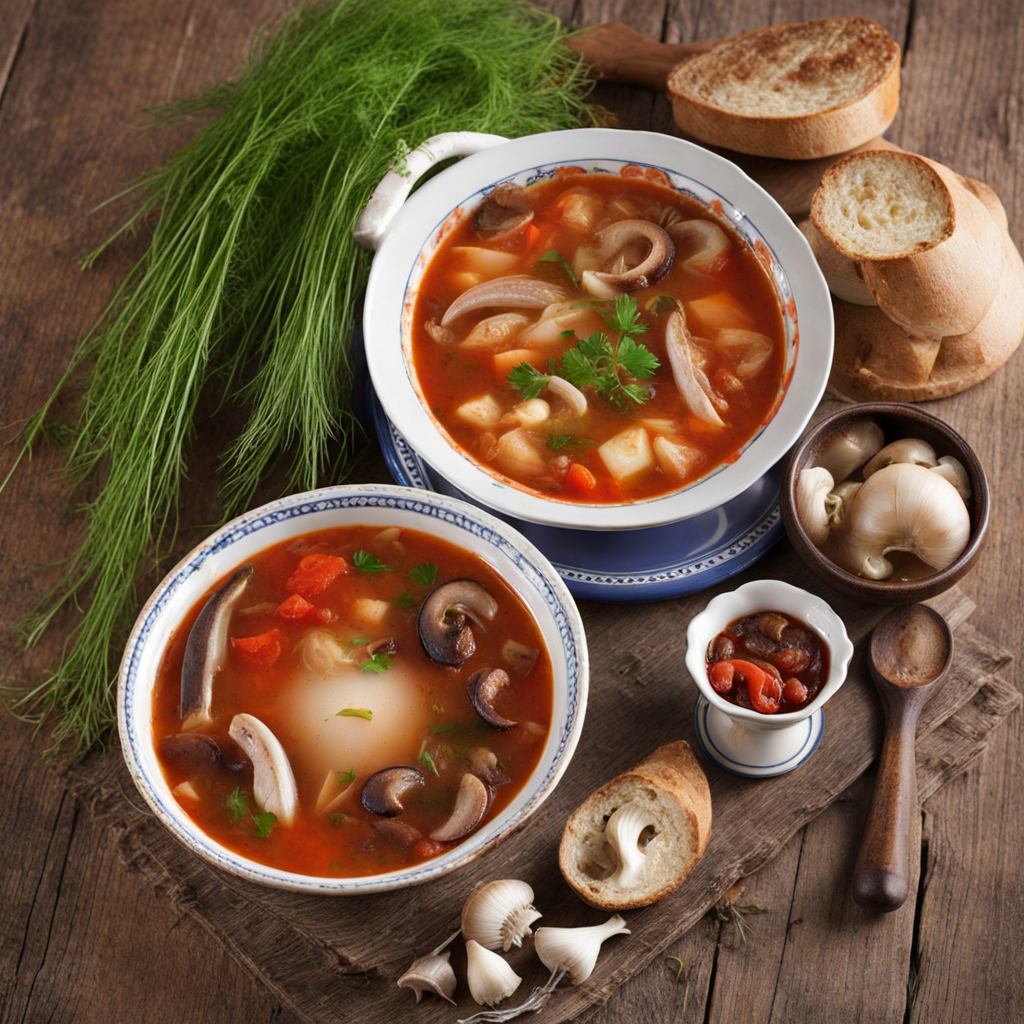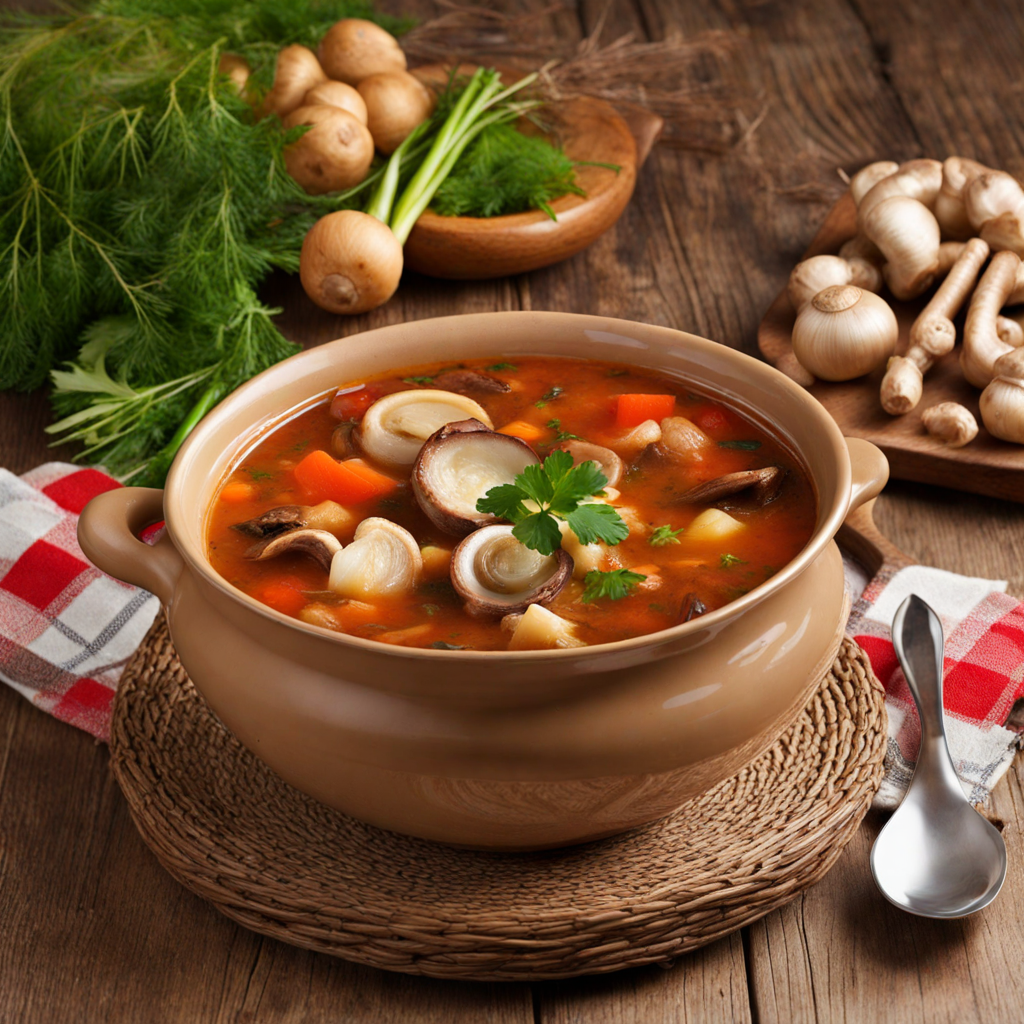Solyanka
Solyanka is a hearty and flavorful soup that originates from Russia, known for its rich and tangy taste. This dish is a delightful amalgamation of various savory ingredients, typically including meats such as sausage, ham, or beef, along with olives, pickles, and a vibrant mix of spices. The base of the soup is often made from a robust broth, which may include elements like tomatoes or tomato paste to lend a zesty punch. The combination of these ingredients creates a dish that is both comforting and invigorating, with layers of flavor that dance on the palate. This soup is celebrated for its versatility; there are many regional variations, allowing cooks to adapt the recipe based on local preferences or the ingredients at hand. Some versions may incorporate mushrooms, cabbage, or even fish, while the addition of sour cream on top provides a creamy contrast to the soup's acidity. The presence of capers and olives enhances the umami profile, making Solyanka a complex dish that satisfies both the appetite and the senses. Served hot, Solyanka is often enjoyed as a first course but can easily stand alone as a meal with the addition of crusty bread or rye. Its bold flavors make it a perfect choice for those seeking something beyond the ordinary, and it is especially popular during colder months. Whether shared among friends at a cozy gathering or savored alone, Solyanka offers a unique taste of Russian culinary tradition that is sure to leave a lasting impression.
How It Became This Dish
The History of Солянка: A Culinary Journey Through Russia Sолянка, or "solyanka," is a traditional Russian soup that embodies the richness of Russian culinary heritage. With its origins steeped in rural life and evolving through centuries of cultural interactions, солянка serves as a delicious reflection of Russia's history, regional diversity, and communal spirit. #### Origins and Early Development The roots of солянка can be traced back to the medieval period, around the 15th century. It is believed to have originated as a peasant dish, born out of necessity and resourcefulness. The name 'солянка' derives from the Russian word "соль" (sol), meaning salt, highlighting the dish's essential seasoning and its fundamental role in preservation. Historically, solyanka was a way to use up leftover meats and vegetables, reflecting the frugality of rural households where nothing went to waste. In its early formation, солянка was characterized by a simple combination of meat, brine, and a variety of vegetables, typically including cabbage, onions, and potatoes. The soup's base was often enriched with sour components such as pickles or fermented foods, a hallmark of Slavic cuisine. As salt was a vital preservative, солянка was particularly popular among sailors and travelers who relied on its longevity and nutritional value. #### Cultural Significance Sолянка transcends mere sustenance; it has become a cultural symbol in Russia. This dish is often associated with gatherings and celebrations, making it a staple at festive occasions, family gatherings, and communal meals. Its hearty and robust flavor encapsulates the warmth of Russian hospitality and the importance of community. In Russia, food is deeply intertwined with social customs and traditions. Solyanka serves as a social glue, bringing people together around the table. The act of preparing and sharing this dish fosters connection and reinforces bonds within families and communities. It's common for families to have their own unique recipes, passed down through generations, each adding a personal touch to the dish while preserving its essence. #### Variants and Regional Differences As Russia is vast and diverse, so too are the variations of солянка. The dish has regional adaptations that reflect local ingredients, culinary traditions, and cultural influences. The three primary types of солянка are meat, fish, and mushroom, each offering a different taste experience. 1. Meat Solyanka: This is perhaps the most well-known variant, featuring an assortment of meats—such as beef, pork, sausage, or even game. The meats are usually smoked or cured, adding a depth of flavor that distinguishes this version. The inclusion of olives, capers, and pickles contributes to the soup’s signature sourness. 2. Fish Solyanka: Often found in coastal regions, fish солянка features a variety of fish, such as salmon or pike, and may include seafood like shrimp or mussels. This variant is lighter than its meat counterpart, yet it retains the same complex flavor profile, enhanced by the natural brininess of the ocean. 3. Mushroom Solyanka: A vegetarian alternative, mushroom солянка showcases the rich variety of wild and cultivated mushrooms found in Russia. This version is particularly popular during Lent and among those who abstain from meat. The earthy flavors of the mushrooms combined with pickled vegetables create a satisfying and flavorful dish. #### Evolution Through Time The evolution of солянка reflects broader historical and cultural changes in Russia. During the 18th century, as Russia began to open its doors to Western influences, culinary practices began to shift. The introduction of new ingredients, such as tomatoes and spices, prompted adaptations in traditional dishes. Solyanka was no exception; the addition of tomato paste became a popular modification, providing a richer color and flavor. The 19th century saw солянка gaining popularity in urban centers, particularly in St. Petersburg and Moscow, where it became a staple in restaurants and taverns. The rise of the Russian bourgeoisie and the growing interest in gastronomy led to the refinement of the dish, with chefs experimenting with different ingredients and presentation styles. In the Soviet era, солянка became a symbol of Soviet cuisine, often served in canteens and public dining establishments. It represented the spirit of collectivism and shared experiences, where individuals from diverse backgrounds could come together over a common meal. The dish was also featured in cookbooks and culinary guides, solidifying its place in the national culinary canon. #### Modern Interpretation In contemporary Russia, солянка continues to be a beloved dish, enjoyed in homes and restaurants alike. With the resurgence of interest in traditional Russian cuisine, chefs are revisiting classic recipes and experimenting with innovative interpretations. Modern solyanka may incorporate gourmet ingredients, artisanal meats, or even fusion elements that reflect global culinary trends. Moreover, the dish has found its way into the hearts of food enthusiasts outside of Russia, thanks to the increasing popularity of Russian cuisine on the international stage. Food bloggers and chefs are sharing their takes on солянка, introducing it to new audiences and celebrating its versatility. #### Conclusion Sолянка is not just a soup; it is a vibrant representation of Russian history, culture, and communal spirit. From its humble origins as a peasant dish to its status as a staple of Russian cuisine, солянка has evolved while remaining deeply rooted in tradition. The dish's ability to adapt to regional tastes and modern influences speaks to its resilience and enduring appeal. As families continue to gather around the table to share a steaming bowl of солянка, they partake in a culinary legacy that spans centuries. In every spoonful, there are stories of resourcefulness, community, and the continuity of tradition—an enduring testament to the rich tapestry of Russian food culture.
You may like
Discover local flavors from Russia







